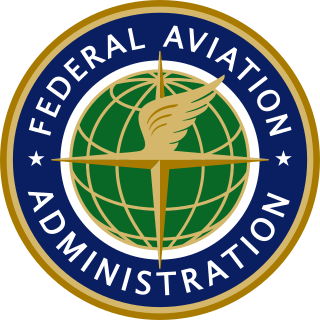
The Federal Aviation Administration (FAA) is a governmental body of the United States with powers to regulate all aspects of civil aviation in that nation as well as over its surrounding international waters. Its powers include the construction and operation of airports, air traffic management, the certification of personnel and aircraft, and the protection of U.S. assets during the launch or re-entry of commercial space vehicles. Powers over neighboring international waters were delegated to the FAA by authority of the International Civil Aviation Organization.

General aviation (GA) represents the private transport and recreational flying component of aviation, as well as the manufacturing or building process of those aircraft.

A flight simulator is a device that artificially re-creates aircraft flight and the environment in which it flies, for pilot training, design, or other purposes. It includes replicating the equations that govern how aircraft fly, how they react to applications of flight controls, the effects of other aircraft systems, and how the aircraft reacts to external factors such as air density, turbulence, wind shear, cloud, precipitation, etc. Flight simulation is used for a variety of reasons, including flight training, the design and development of the aircraft itself, and research into aircraft characteristics and control handling qualities.

A Ground Proximity Warning System (GPWS) is a system designed to alert pilots if their aircraft is in immediate danger of flying into the ground or an obstacle. The United States Federal Aviation Administration (FAA) defines GPWS as a type of terrain awareness warning system (TAWS). More advanced systems, introduced in 1996, are known as enhanced ground proximity warning systems (EGPWS), although sometimes called terrain awareness warning systems.

Vaughn College of Aeronautics and Technology is a private college in East Elmhurst, New York, specialized in aviation and engineering education. It is adjacent to LaGuardia Airport but was founded in Newark, New Jersey in 1932 before moving to New York City in 1940. The college's most recent name change, to honor a founder, was on September 1, 2004.

A private pilot licence (PPL) or, in the United States, a private pilot certificate, is a type of pilot licence that allows the holder to act as pilot in command of an aircraft privately. The licence requirements are determined by the International Civil Aviation Organisation (ICAO), but implementation varies widely from country to country. According to the ICAO, it is obtained by successfully completing a course with at least 40 hours of flight time, passing seven written exams, completing a solo cross-country flight, and successfully demonstrating flying skills to an examiner during a flight test. In the United States, pilots can be trained under Title 14 of federal code part 141, which allows them to apply for their certificate after as few as 35 hours. However, most pilots require 60–70 hours of flight time to complete their training. The minimum age for a student pilot certificate is 14 for balloons and gliders, and 16 for powered flight. The minimum age for a private pilot certificate is 16 for balloons and gliders, and 17 for powered flight. Pilots can begin training at any age and can solo balloons and gliders from age 14, and powered aircraft from age 16.

Reno/Stead Airport is a large public and military general aviation airport located in the North Valleys area, 10 nautical miles (19 km) northwest of the central business district of Reno, in Washoe County, Nevada, United States. A former military installation until 1966, when it was known as Stead Air Force Base, the airport's sole remaining military presence consists of an Army Aviation Support Facility and the 189th General Support Aviation Battalion of the Nevada Army National Guard, flying CH-47 Chinook helicopters. The airport is owned by the Reno Tahoe Airport Authority. The National Plan of Integrated Airport Systems for 2011–2015 categorized it as a general aviation reliever airport.

A fixed-base operator (FBO) is an organization granted the right by an airport to operate at the airport and provide aeronautical services such as fueling, hangaring, tie-down and parking, aircraft rental, aircraft maintenance, flight instruction, and similar services. In common practice, an FBO is the primary provider of support services to general aviation operators at a public-use airport and is located either on airport leasehold property or, in rare cases, adjacent to airport leasehold property as a "through the fence operation". In many smaller airports serving general aviation in remote or modest communities, the town itself may provide fuel services and operate a basic FBO facility. Most FBOs doing business at airports of high to moderate traffic volume are non-governmental organizations, i.e., either privately or publicly held companies.
Crew resource management or cockpit resource management (CRM) is a set of training procedures for use in environments where human error can have devastating effects. Used primarily for improving aviation safety, CRM focuses on interpersonal communication, leadership, and decision making in the cockpit of an airliner. Its pioneer was David Beaty, a former Royal Air Force pilot and later a BOAC pilot who wrote his seminal book The Human Factor in Aircraft Accidents in the late 1950s. Despite the considerable development of electronic aids since then, many principles he developed continue to prove effective today.

New York’s Orange County Airport is an untowered airport located one nautical mile (2 km) southwest of the village of Montgomery, in the Town of Montgomery, United States, at the junction of state highways 211 and 416. It is owned and operated by Orange County. It is included in the National Plan of Integrated Airport Systems for 2011–2015, which categorized it as a general aviation facility.
The Advanced General Aviation Transport Experiments (AGATE) project was a consortium of NASA, the FAA, the general aviation industry and a number of universities. Its goal was to create a Small Aviation Transportation System (SATS) as an alternative to short-range automotive trips for both private and business transportation needs. The Small Aviation Transportation System will make many time-sensitive short-haul trips more affordable for business, medical, public safety and recreational pursuits.

Michael George "Mike" Goulian is an American aerobatic national champion aviator, who races in the Red Bull Air Race World Series under the number 99.
The Next Generation Air Transportation System (NextGen) is an ongoing modernization project of the United States National Airspace System (NAS). The US Federal Aviation Administration (FAA) began work on NextGen improvements in 2007 and plans to have all major components in place by 2025.

The Aviators Code Initiative (ACI), formerly the Aviators Model Code of Conduct, is a set of model recommended practices designed to improve general aviation safety and airmanship.

The Air Traffic Organization (ATO) is America's air navigation service provider, as the operations arm of the Federal Aviation Administration. Its customers are commercial and private aviation and the military, and it employs more than 35,000 controllers, technicians, engineers and support workers.
In the United States, a Designated Pilot Examiner (DPE) is a senior pilot who examines applicants for a Pilot Certificate on behalf of the Federal Aviation Authority (FAA). The DPE must check applicants’ qualifications, conduct an oral test of their mental skills and judgment, and perform a practical test in flight. DPE's sometimes double as FAA Aviation Safety Inspectors.
Mike Monroney Aeronautical Center is administered as one of the FAA Regional Offices.

The Society of Aviation and Flight Educators (SAFE) is a professional organization open to all aviation educators, including flight instructors, ground instructors, academicians, and others who have an interest in aviation education. Founded in Connecticut in early 2009, SAFE "facilitates the professional development of aviation educators [and] seeks to create a safer aviation environment through enhanced education." SAFE is governed by a Board of Directors composed of nine members, all of whom are elected by the SAFE membership in a rotating three-year cycle.
Spartan College of Aeronautics and Technology (Spartan) is a for-profit aviation institute in Tulsa, Oklahoma that offers training in aviation, aviation electronics, flight, nondestructive testing, quality control and aircraft maintenance. Originally established to provide pilot and technicians for Spartan Aircraft Company, it outlived its parent company and continues to train pilots and mechanics into the 21st Century. The main campus is adjacent to Tulsa International Airport, with another campus used for flight training at Richard Lloyd Jones Jr. Airport.

Civil Aerospace Medical Institute (CAMI) is the medical certification, education, research, and occupational medicine wing of the Office of Aerospace Medicine (AAM) under the auspices of the Federal Aviation Administration Office of Aviation Safety. The Institute's primary goal is to enhance aviation safety.











